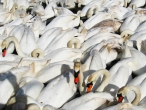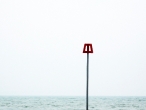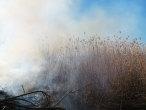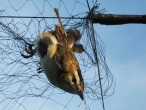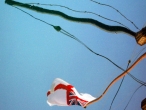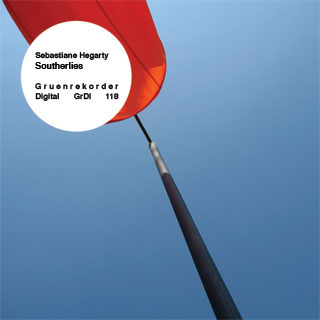
Southerlies | Sebastiane Hegarty
GrDl 118 | Gruen Digital > [order]
MP3 & FLAC
Eight soundscapes from the south of England
As a visual artist working with sonic information, I am drawn to the spatial and temporal qualities of sound. I am interested in how sound and listening places us in the world: what could be called the acoustic and perceptual geographies of time and place.
Recording has become a habit, a method of engaging with the world around me. I use an array of contact microphones, hydrophones and other microphone technologies and recording methods, to help me listen in on the acoustic environment.
Walking and listening have become associates in the compositional process. Yet my walking, like my listening, has a tendency to wander. I saunter, meander and go astray in a seemingly aimless transit. This wayfaring draws out a line of listening and recording that develops freely and in its own time, it happens upon sounds, and discovers the unsought through the unintentional.
This series of soundscapes were originally composed for broadcast on BBC Radio Solent and were located in response to suggestions from members of the listening audience; some of these locations were familiar to me; most were not.
The process of composition was consistent: I would arrive at a location, encumbered with a bag of microphones, recorders, headphones and a blimp; I would then spend the day wandering around listening (and recording) to see what sounds were available to hear. Once home the recordings were named and downloaded. I would then explore them again, listening and recomposing the soundscape in order to discover a sense of place or rather, allow it to emerge. Each soundscape uncovers a certain disposition, a particular relationship with time and place.
Winchester Cathedral*
11:56/2011
51.060696° N, 1.31321° W
MP3
Opening with the sonic arch of iron gates, the soundscape takes a journey of ascent through the architecture and circadian rhythms of Winchester Cathedral. A sense of anticipation permeates the soundscape as Matins prepares the day with prayer, the organists rehearses a phrase, whilst elevated seating is installed to raise the voices of a choir. An orchestra prepares for the evening concert of Hayden’s Creation, a solo voice ascending as I climb into the bell tower where the mechanism of the clock prepares to announce a quarter in anticipation of the hour.
*This is an extended version of the Cathedral soundscape, composed as part of an installation for the Ten Days Across The City event at The Theatre Grand, Winchester (2011).
Hengistbury Head
06:00/2011
50°42′53.17″N, 1°45′17.68″W
MP3
Hengistbury Head is a historic headland that juts out into the English Channel.
Arriving in the car park at Hengistbury Head, I am greeted with a radiophonic static chorus of Starlings. Their song signals my arrival within a spectral landscape: a place between stations, continually ebbing in and out of existence. In the sheltered quiet of the landscape behind the Head emerges an ethereal harmonic hum, as the sea breeze brushes through a wire fence.
A dog running through the lap of the salt marsh shore, leaves a wet stereophonic tear in the tidal two and fro as the approaching meditative hum of the land train drags a trace of human presence across the landscape. Sunk beneath the beach a hydrophone offers a Geiger like calculation of each sonic particle of sand. As rain clouds approach and the air pressure drops a contact microphone finds a single wing nut at the top of an empty flagpole, pealing out an unheard yet clangorous alarm.
Hamble
06:00/2011
50°51′25″N, 1°19′15″W
Hamble le Rice is a small village situated on the River Hamble.
A soundscape of repeated departure beginning with the yank of a two-stroke engine and the propeller push of a small boat leaving a forlorn jetty, that whines with the tide and a continual wash of farewell. The gamelan clatter of masts and flagpoles suggest a landscape of movement tethered: departure paused by the clasp of the land and the fibrous grip of rope. The gunfire signal of a false start punctures a violent hole in the audible plastic sheath of air caught in sail. A vibrant pink ferry transports its passengers across the River Hamble, leaving and returning with a loud subaquatic and effervescent goodbye.
HMS Victory
06:00/2011
50° 48′ 8″ N, 1° 6′ 41″ W
The dry dock where Victory is now enclosed, preserves those once saturated timbers in a sea of arid reverberation. Over the boarding bridge the footfall and voices of French school children now invade the decks where once Lord Nelson defended the realm. In the compressed architecture of the ships decks, the sound of footsteps, close to and far away, suggest a ghostly landscape, where movement is heard but not seen. Recorded announcements accentuate the sense of desertion, as they rise with fragments of song like acoustic smoke through the ship, surfacing at the bow in the metallic voice box of the galley stove flue. The siren hum of empty rigging haunts the air, whilst gulls lament and the abrasive lines of cordage scratch at the ear.
Watercress Line
06:00/2011
51°08′59″N, 0°58′37″W
MP3
The watercress line is a preserved steam railway that connects New Alresford to Alton in Hampshire.
The concentrated temporality of train stations is augmented by the steam engine, the lull of birdsong and occasional footfall closes quietly behind the cacophonous weight of arrival, as the train yelps to a standstill. The ritualistic choreography of coupling, signal bells and points, heralds the physical trauma of stillness wrenched back into motion The wake of silence that follows departure, brings into focus the miniatures of sound previously unheard: the dissonance of departure reveals the uncertain sound of a sack trolley, crossing the rails of transport between platforms of stillness.
Abbostbury Swannery
06:00/2011
50°39′ 54″ N, 2°36’3″W
The Swannery at Abbotsbury in Dorset was established in the 11th century by Benedictine Monks, who farmed the swans for food.
The atmosphere of silence that surrounds Benedictine monks and the supposed muteness of swans, sits in counterpoint to a soundscape where voice continually announces presence and disappearance. The bleat of spring lambs is accompanied by the call and response of children disappearing into a maze and the voices of parents calling them back into existence. The idle quiet chatter of beaks preening feathers and arranging eggs, is interrupted as a swan plunges into water and presence. Behind the acoustic cladding of Chesil Beach, the lull of Fleet lagoon is broken by a sudden free jazz duet of two feral swans and the approaching steps of the swan herd. As the swan herd shovels wheat into air, the gluttonous savagery of the mute colony is revealed; a deluge of veracious beaks devouring every single grain.
Lymington Ferry
06:00/2011
50°45′N, 1°33′W
The Lymington Ferry collides daily with the port of Lymington on the English mainland and the port of Yarmouth on the Isle of Wight.
A quiet stillness surrounds the terminus interrupted only by the flutter of a flag chewing on air. In amongst the prayer bell chime of sailing boat rigging, a gentle engine hum approaches. In seismic slow motion the steel of the ferry collides with the pillow of the dock. On departure this gnarl of metal and rubber is replaced by a soporific hum of apparently motionless movement as the ferry passes out into the channel through a noiseless landscape. The electronic voice phenomena of radio communication measures distance and pronounces territory, before arrival releases the disembarked percussion of cars wheels on metal and tarmac. From the dock at Yarmouth the wake of the ferry’s departure leaves behind a slosh of water, whilst an advertising sail mouths the air and gargles with the southerlies.
Winnall Moors: a short walk through a year
06:30/2011
51°04′21″N, 1°18′11″W
Winnall Moors is a Hampshire Wildlife Trust conservation reserve, close to the city centre of Winchester. This soundscape is a condensed version of the four seasonal sound walks from the winnall moors soundwalk project. The project was funded by HWT and I am grateful to the employees, scientist and volunteers of the Trust for their knowledge and assistance.
An abbreviated year opens with the crackle of frozen steps walking through Christmas Day and out into the dawn of summer solstice. As ringing nets are assembled, captured birds hang in cotton bags waiting to be rung. The rustle of feathers against fabric introduces an eerie claustrophobic air. The perambulation of composition brings together the gentle voice of water passing through a river hatch and the magnified reverberation of a path closure, as a temporary metal fence interrupts the landscape. The percussion of rain on barbed wire accompanies the human rhythms of hammer and nail and the amorous serenade of a water boatman. The soundscape concludes underneath the creaking shade of a HWT pagoda, erected on the 50th anniversary of the Wildlife Trust.
8 Tracks (55′02″)
Website: sebastianehegarty.com
Blog: sebastianehegarty.wordpress.com
Project Blog: winnallmoorssoundwalk.wordpress.com
Field Recording Series by Gruenrekorder
Gruenrekorder / Germany / 2012 / GrDl 118 / LC 09488
Russell Cuzner | Musique Machine
Southerlies collects together a series of field recordings each focussing on a single specific area in the South of England. Commissioned and originally broadcast by BBC Radio Solent, the artist, writer and lecturer Sebastiane Hegarty was sent to the eight locations on the suggestion of the station’s listeners to „uncover a certain disposition, a particular relationship with time and place,“ as he puts it.
‚Winchester Cathedral‘ opens, literally, with keys unlocking a gate, its metallic percussion accompanied by footsteps to arrive upon an organist rehearsing. Rather than capture the music, though, Hegarty nimbly gathers the confluence of its notes with all the other audible events populating the cathedral. This affords a clear impression that our brains would normally filter out of how purposeful, unrelated sounds (such as an orchestra tuning up and individual conversations) combine with incidental and accidental noises (like whirring machines or the rustle and hum of an expectant audience).
The rich and tempting draw of the coast is lavishly illustrated on ‚Hengistbury Head‘, where lush, leisurely water sounds preside majestically over twittering starlings, throbbing diesel engines and children at play. But placed stealthily throughout are the less recognisable sonic events such as a tonal hum (possibly the result of micing up a wire fence and letting the wind compose the drone) or the tribal rattle of the piece’s finale (apparently a loose wing nut on a flagpole portending a change in weather).
There’s more sloshing about on ‚Hamble‘, but this time it seems more about what’s on the water than the water itself. Masts provide a kind of loose, free jazz percussion as they are conducted by a wind abundant in birdlife before man-made movements threaten and eventually succeed in dominating the sound field, concluding with the aggressive churn of a ferry’s engine.
A contrasting dryness is emphasised on the following track, despite it being a record of a sea vessel. The first half of ‚HMS Victory‘ deals with the deep creaks and metallic resonances of the ship as they affect the pre-recorded narrations of this dry-docked tourist attraction. But the second half gives way to ominous rushes of air that sinisterly weave through the rigging, perhaps as a psychogeographical reminder of the warship’s original purpose.
‚Watercress Line‘ also celebrates yesterday’s modes of transport. Here we get to sit on a steam train as the mechanical clicks and clatters of the signal box give way to the coughing of water vapours. Like the previous track, the visitor-friendly atmosphere is replaced by the more serious vibe, with the cyclical march of powerful engines and an awesome rattle before squealing to a halt.
‚Abbotsbury Swannery‘ puts us back on the water near to where noisy families watch largely silent swans while ignoring the equally cheerful bleats of a herd of sheep. But the stereotypical serenity gives way to frustration as Hegarty somehow manages to capture the swans snorting, flapping, crying and snarling seeming provoked and defensive.
Closer to industrial or noise music, Hegarty’s recording of ‚Lymington Ferry‘ feels like a Futurist celebration of engineering. Set against an otherwise bucolic buoyancy, the ferry’s complaining engine roars and twists like a mechanical Leviathan emerging from the depths. It’s accompanied by a devilish rattle with occasional snatches of distorted radio talk to create a dystopian atmosphere belied by its benign source.
The collection concludes with a sound survey conducted over a year at a conservation reserve near Hegarty’s home of Winchester. ‚Winnall Moors‘ starts by highlighting an abundance of bird life, including particularly disturbed ones apparently caught in a net, before voyeuristically settling near work men erecting a fence whose toiling tools and wiry resonances parade over their banter.
As the brief descriptions above hopefully indicate, these eight soundscapes are far more than the academic, ontological documentaries the original concept suggests. In Hegarty’s hands the gathered sounds from each location become deftly structured to form what feels like fully-fledged musical compositions. Each has a clear beginning, middle and end – something that much music played on conventional instrumentation often lacks. So, even when the sounds available deny him any tonal or percussive matter, the way they’re blended provides all the necessary peaks and troughs you’d expect from compositions filled with melody and rhythm. Each of the eight pieces exhibited here, while presenting such a balanced record of man and nature’s contributions to contemporary environments, draw the listener in by highlighting the musical qualities of found sound, building to crescendoes and forming contrapuntal exchanges filled with intrigue.
link
Jack Chuter | ATTN:Magazine
The Winchester-based sound artists navigates through old ships and beautiful cathedrals, in a new work on Gruenrekorder.
“My walking, like my listening, has a tendency to wander”.
This quote from Hegarty is made incredibly apparently during his sonic exploration of Winchester Cathedral: the gorgeous lull of choir song wafting warmly around the building’s large interior is cut off abruptly by the slam of a metal gate, marking his departure and subsequent “wandering off” into the outdoors. Far from disappearing within his work and letting the places take the fore, Hegarty is the protagonist – the composer, the active party – dictating the direction of each piece simply by moving within the soundscape, pushing back against the inescapable imposition of sound to reclaim a degree of control over the listening experience. There’s no sense of trying to capture the essence or definitive sonic picture of a location, and rather than simply lure the listener into a deeper and more attentive state of listening, Southerlies is a fascinating reminder of the fact that the ears are mobile things, and that secrets and hidden narratives can be uncovered when one is willing to move out into the space around them.
“HMS Victory” hears Hegarty ducking and slinking between creaking beams and wooden panels, occasionally emerging on deck to the distant squawk of seagull and ghostly drone of faraway traffic. On “Watercress Line” (a steam railway running through Hampshire, England), we hear the preparatory clangs and rustles that precede the train’s departure, followed by the accelerating huffs of steam that signify its movement. The album is littered with sounds (or shifts between sounds) that signify movement and transition: opening/closing gates, fading conversations, loose surfaces rattling under propulsive forces, the gradual muffle of moving from the outside to somewhere inside. The experience is wholly subjective one – not the documentation of a place but the chance narrative that arises from navigating a unique path through it, bustling with the sound of activity and interconnection; human communication, collisions of characters and events, impacts and frictions against various surfaces.
Guillermo Escudero | Loop
This a new release of the ‚Field Recordings‘ series of this German label.
Sebastiane Hegarty is an artist, writer and lecturer who has an interesting statement: ‚walking and listening have become partners in the process of composition. Yet my walk, as my listening tends to wander‘. And of course, an artist whose creative process is based in nature and time and his interest in doing research about time, place and the sensations they produce, develops a keen listening associating to certain emotions.
Another interesting issue is Hagarty’s on acoustic ecology and the perceptual geographies of sound and audition, through field recordings and soundscape composition.
‚Winchester Cathedral‘ is a recording that takes place in this beautiful Gothic cathedral in Hampshire, England.
Hengistbury Head is a sandstone headland which forms part of Southbourne, the most easterly part of the Borough of Bournemouth, Dorset. Hamble-le-Rice is a village in the Borough of Eastleigh in Hampshire. HMS Victory is a ship of the Royal Navy, laid down in 1759 and launched in 1765. Here it can be hear the birds that surround this ship, children, people walking.
The Watercress Line is the marketing name of the Mid-Hants Railway, a heritage railway in Hampshire. The sounds of a train passing through the railway and people talking is the sound environment of this track. ‚Abbotsbury Swannery‘ is the only managed colony of nesting mute swans in the world. It is situated near the village of Abbotsbury in Dorset. ‚Lymington Ferry‘ is a route for vehicles to the Isle of Wight which is between Lymington, in the New Forest and Yarmouth in West Wight. The noise captures the running ferry, speaker voices and water.
Winnall Moors is an area of the flood plain of the River Itchen, immediately to the north of Winchester city centre. Hegarty recorded in this last track the rich flora and fauna of this natural reserve.
‚Southerlies‘ is a trip to various places in England in which Hegarty captures the different geographies and sounds both natural and manmade.
Patrick Farmer | The Field Reporter
Saunter. Late 15c, santren, “to muse, to be in reverie,” of uncertain origin. The meaning, “walk with a leisurely gait”, is from the 1660s and may be a different word entirely. Some suggest this word derives via the Anglo-French, sauntrer, originating in the mid 14c from the French, s’aventurer, “to take risks.”
“I have met with but with one or two persons in the course of my life who understood the art of walking, that is, of taking walks, – who had a genius, so to speak, for sauntering: which word is beautifully derived “From idle people who roved around the country, in the middle ages, and asked charity, under pretence of going, á la Sainte Terre,” to the holy land, till the children exclaimed, “There goes a Sainte-Terrer, a saunterer, a holy lander. [sic]”
– Henry David Thoreau, On walking
Winchester Cathedral
Listening with microphones changes a person, and I am speaking from experience. Here Sebstiane Hegarty has decided to ground us inside the din of an excitable audience expectant of the spiritual tonality emanating from Haydn’s oratorio, Creation. As these familiar sounds come through my speakers, I hear the squeaking of a child’s, or even a dog’s, toy. And now I understand, I remember. If I were an audience member at this event, though I realise that here I am the sole audience, experiencing a composition in which I can’t imagine anything was left to chance in the meticulous post production process, I doubt I would have thought twice about such playful colour sneaking out above the white noise that surrounded me. But as a recordist, I imagine Hegarty was smiling, his blood rushing, ensconced as he was, in his auditory vantage point. Listening with microphones brings these occurrences, not into perspective; but out, away from, it heightens them. When something pokes out, the microphone latches on; it’s almost like fishing. It’s as if this whole section depends on that seemingly insignificant event.
From the outset it’s apparent how much Hegarty enjoys jump cuts, the confusion of chronology, a timescale that, when we read about this piece, seems relatively straightforward, but when time exists solely in the ear, where are we? There is an intriguing use of the overlooked and underheard mechanisms that provide function, the automated objects that make such events as those we are hearing possible. As Hegarty never really allows the piece to build in momentum, it appears wildly juxtaposed against the crashing waves of Haydn’s epic.
Hengistbury Head
I wonder what Hegarty is trying to do here? Is he trying to capture the auditory quiddity of an environment? He says:
“Sunk beneath the beach a hydrophone offers a Geiger like calculation of each sonic particle of sand”
Hegarty talks of ripping apart the totality, “the beach”, to stare at singularity, “each particle of sand”, but then how is this possible in 6 minutes? Leading me to think I would very much enjoy hearing the elongated versions of these recordings. This would give the individual events time to sink in more deeply, allowing them to gestate, and interact with the environment they have suddenly found themselves in, or is it the other way around? Who knows.
What Hegarty calls an “unheard yet clangorous alarm.” Provides the coda for this composition, and its length, its entrance appearing in an intuitive manner, almost as if it placed itself there, is a perfect contrast to the rushed elements that preceded it. The tonality and life of this recording as a thing in itself, though of course it is the product of a collision of sources, pertains to a vast spectrum of diversity and repeated listening.
Hamble
Beginning with the familiar sounds of black headed gulls, I don’t feel that I need too contribute anymore description than that, one only needs look to Hegarty’s notes, the sound that flutters in and out of my vision, at first sounding like the swinging of a rusty gate, is what keeps me here – putting aside my issues for a moment, of the penchant of the recordist to constantly and doggedly seek the fantastical, to overlook what is raw and compelling about so much of the everyday – for a moment I understand what is all about, I hear this sound, and immediately I try and erase the image of any sort of gate from my mind, to try and just be here, wherever it is that I am. Who knows, perhaps it is a gate, but that is the beauty of it, I don’t know. The structure of this piece is such that the highly familiar provides a barrel of contrast toward that which is specific to location, and it evokes in me a feeling, not of being there, but of being nowhere, of enjoying feeling lost, revelling in it, rolling all over the sounds as they continue to elude me. And this is something quite unique I feel, overexposed as we are these days to whatever it is we should wish, of being able to proffer that feeling of joy, analogous to the feeling I touched upon with the squeaky toy in the audience, for Hegarty himself.
And like Hengistbury head, it is once again apparent that Hegarty does not shy away from ‘reality’, the machines that exist all around us. Perhaps he includes them as a statement, to show us what these machines are doing to our landscape, to our state of hearing in general, but I get the feeling that he enjoys them, (it would be too easy to mention John Cage here) in a manner similar to the myriad other sounds on offer, the sounds the recordist must dig for, deeper and deeper as the field progresses and the general rumpus becomes ever more grating.
HMS victory
Reading through Hegarty’s texts, perhaps isolated would have been a more apt description than arid? For me the former noun manifests throughout this piece, the structure eventually settling into a layered frame of predominantly surface recordings that manage to project the images of the choppy sea, without, and I feel this to be a positive, the familiar and all too frequent use of the sea itself. Sound bleeds through various surfaces as voices are heard through metal and the metal itself continues to amplify its expanding and contracting contents until briefly moving through physiological bodies in a fugue like atmosphere of the maritime past.
This recording takes on a new image of figure and ground, but it is one that, again, I would have preferred to have been able to experience over a longer duration. The fleeting glimpses of voices snatched through the bowels of the ship admirably provide an imagistic sense of place before scuttling back into the wellspring of structure, but the progression that it implies is so very specific that this novel approach to composition ends up looking back on itself and leaves the listener unsure as to whether they are on an esoteric tour of the HMS victory or in the ears of a guide who wishes to get off work early. Thus I end up wondering if it is perhaps a judgement on behalf of the recordist on the value of the more ambient snatches of recordings, and the inaudible surface, the latter retaining its amorphousness through the filtering of vibration into unrecognisable and fantastical states of audibility.
I say this because the accompanying text, rich in imagery and sonority, promotes a sense of the time spent in this location, of the evident contemplation and stillness that might have perhaps prompted these tracts of inspiration and, dare I say it, romanticism. Perhaps I am wrong in thinking of the two as one, the text and the recording serving the same purpose, but nevertheless, that is my interpretation, packaged together as they are, and I can’t help but feel that they pertain to two entirely different locations in the manner of their delivery and reception.
Watercress line
Before I heard this recording, as full as it is of commonplace sounds, I started thinking of the hugely personal nature of the written word in the light of the perceivably objective nature of the invisible recording. Reading sentences such as – “…physical trauma of stillness, dissonance of departure, uncertain sound, platforms of stillness…” These descriptions help to bring Hegarty into the frame he created, they shows signs of life, but I feel it is important to perceive such from a distance in order to successfully differentiate between Hegarty’s sensation and that of your own.
As is the theme, this recording weaves neatly and fluidly through the distinct and the subsequent extractions of the distinction in which we temporarily become familiar. The recording quality of the train itself rears up in its chiefly state before succumbing to, I’m guessing, the sack trolley mentioned in the text, creating a sense of disturbance that one can’t help but revel in. This piece in particular is teeming with psychological association, sending the listener’s sense of scale reeling between the poetic, a sound that can only be described as the railway track trying to tear itself lose from its foundations in anticipation of the incoming train (this is my interpretation of the sound, and I doubt I am correct), and the commonplace, the muffled sounds of passengers, I so often cover my eyes in such a situation, as the train rears up toward the designated platform.
Abbotsbury Swannery
“The atmosphere of silence that surrounds Benedictine monks and the supposed muteness of swans, sits in counterpoint to a soundscape where voice continually announces presence and disappearance”
As a recording this shows remarkable restraint, I’m sure Hegarty could have plastered the walls of our homes with the ronking and corking of Mute Swans as they protect their nests, surging into action as they detect the slightest fluctuations of air pressure. Instead we are left with a conglomeration of densely rich and spatially varied instances that move in and out of the more familiar frame of the gliding habits of these creatures. We hear the frapping and bonking of feathers and the distinctly high-pitched calls of their young as they discover and test their environment; part of what Hegarty playfully and anthropomorphically refers to as a, “free jazz duet”. Even with his accompanying text it is easy to become lost in this strange and oddly restful series of bumps and groans, happy not to be involved in the risk of recording such protective and territorial creatures.
Hegarty makes his presence more palpable half way through the piece, introducing a mid pace gait on a gravel path, we hear what is fast becoming one of his favourite entr’acte’s, the turning key, and we are submerged, introduced to a remarkable surface, one that only a microphone, in all its reduction, could produce – Hastily shunted from liquid to solid as if the microphone were the animal itself.
Lymington Ferry
The filmic elements of these recordings are hard to ignore, not that we should ignore them you understand, but in almost every piece there is at some point what Godard would call a ‘jump cut’, a jarring editing technique that the director Georges Méliès would use to compliment his filmic illusions. Perhaps it’s more apt in this context to refer to them as short cross fades, but it doesn’t matter, the point being is that no matter how lost we become in these recordings, their simulation of any sort of reality, Hegarty evidently wishes to bring us back to the reality in which we reside, the room in which we listen, ready once more to be lulled by the atmospheric resounding of these aquatic vehicles in motion.
The auditory similarity between this recording and the last doesn’t seem like a chance matter, perhaps there is a statement in there, perhaps not, pertaining to the walls that most field recordists face eventually. Telling of the limited frequency response of their contact microphones, leading to so many seemingly distinct and inaudible phenomena sounding relatively similar when served up in this fashion, leaving, in this case Hegarty, alone in post production, with the impossible consideration of how much of a stamp he needs to leave on proceedings, considering to what extent the sounds can speak for themselves, how much they need to be pushed around, forced to get on, as it were. But interestingly here I find less and less anthropic presence – perhaps this is down to clever microphone placement, which certainly seems the case over the last 30 seconds – with the exception of a voice calling over a radio, but of course even that is an illusion, it is not a ‘real’ voice, without wanting to go too far down that road of what is real in this context. This is interesting for the very reason that I hear the most evidence of post-production in this piece, a sign of a highly considered craftsman moulding sounds only to the extent that he has to, listening intently to the effects of their co-mingling, and responding accordingly. Though I would say that abrupt ending, for once, does not work here, so absorbed was I in the events that were unfolding, on occasion one does not wish to be wrenched back into their surroundings so soon after leaving them.
Winnall Moors: a short walk through a year
Not wishing to labour a point, though I fear it’s too late, but being as this is billed as a soundwalk project, it would have been beneficial to not know what the sounds are, to let them exist in a state of unknowing, letting their interactions form images and opinions that were not coloured by the images already placed in my mind by Hegarty’s careful descriptions.
As is so often the case with field recording, issues that dwarf the sounds themselves arise, and here we have the ringing nets. One listen to the distressed calls of the (Moors Warbler?) that is caught in the net, used to monitor fat content, age, sex, etc, and any empathy in the mind of the listener is drawn sharp, alongside a hefty dose of ones own awareness, or not, of their own contradictions in mind of the implied scientific connotations relating to the managed landscape in which the bird resides. This is not the time or the place to discuss this, but just briefly, as I have often written in my own time about field recording existing as a practise that, although originating in sound, can so often end up as far removed from sound as it is possible to get – relating to the omnipresence of in/au/dibility perhaps. I have often marvelled at our knowledge of the world around us, sitting and reading for hours about sexual dimorphism in deep sea creatures, or closer to terrestrial life, the mate choice hypothesis of Mallards, but, just like many facets of the meat industry, it is often best not to know how such findings arise. An ethical consideration best discussed in another forum I agree, but such is the diversity of sound that I felt compelled to quickly bring this up.
With brief swoops once more between the claustrophobic worlds ordinarily existing beyond our hearing range and the, in comparison, more mundane chatter of workplace conversation, accompanied by the sounds of dragged scaffolding, I assume, we are back into familiar territory and I am left reeling once again at the imagery, what the poet Ezra Pound referred to as, Melopoeia, if I may re-appropriate, that is suffused around the bodies of sound given to us, charging them with a strata of meaning and interpretation where we cannot help but be thrust into the imagery of the dedicated field recordist purposely caught in a blustery rain storm, sticking it out with a smile on his face due to the sheer and perpetual craziness of amplified minutiae.
Hegarty does an admirable job of encapsulating his year-long list of experiences into a concrescent audible bower, pulling together various senses of wonderment and nostalgia, and attempting to encapsulate the diversity of life over and under the surface at Winall Moors. From the loudest insect in the world to yet another presentation of those elements in our lives that we can so often take for granted. And it occurs to me that the previous sentence seems to surround Hegarty’s aesthetic as it in turn surrounds the listener.
I have listened to these recordings a number of times now, and having extracted many threads from the garment, so to speak, and with this in mind I decided to try and listen in a manner befitting a whole in which I would attempt to perceive a sense of commonality, or reoccurrence. I think it is testimony to Hegarty’s ear that having now attempted this I find many elements that appear in most of the compositions on offer, the human voice, lapping water, etc, that when listened to up close, don’t appear quite so plainly.
I feel this speaks of the importance of listening as a totality of experience. Of not only the much idolised close listening, but also of the, not only ability, but willingness, to let an environment wash over you. To not feel the need to pinpoint each exact sound, to know what it is, to know why it is, thus forgetting so much. Of each to its own occasion, of feeling over intellectualising.
It is my opinion that these recordings would have been better served without their textual counterparts. Imagine residing in such wonderful environments as these, only to have an individual reading to you, over the top of your experience, of the environment they themselves are receiving. Jack Spicer once wrote, “The sea does not suffer diminution”, and I find this to be a similar experience. The recordings themselves are full of the joy of discovery, as are the texts, which of course one could also claim to be recordings, but placed together they can create a misaligned composite, highlighting what Roland Barthes tended to call an “Extreme disparity of structure”.
However, if we imagine the text as subtitles over a series of still or slightly fluttering images, then things begin to make more sense. This release pertains to an individuals methods of perceiving a world in all its multiplicity, once it is out in the world however, it is up to those who receive it to act accordingly, to ignore or follow, to eavesdrop or place their fingers in their ears.
As I follow accordingly, I consider that for me it would be germane to consider the text as post interpretation. A review of Hegarty’s recordings by Hegarty himself in an attempt to evoke in the reader similar sensations to which the environments initially aroused in the recordist himself.
The difficulty of translation, of correspondence, can also lead me to conclude that these depictions, whilst pertaining to the same experience, move beyond this and comment on the impossibility of exactitude, the feasibility of the near miss and the metaphysic that each perception is always in need of its own method. That although the text and the audio refer to the same environment contextually, they were created at different times thus they refer to different environments, to flux and external conditions. I am typing out loud here of course, but it is a method of understanding that I am after, a comment on the presentation not only of that which we hear but how we hear it, how the recordist may expect us to listen, and what to listen to.
[…] I’ve continued with Sebastiane Hegarty who made a perfect transition with what you have listened to before with those soundscapes under the name “Southerlies” on the label Gruenrekorder. All of the recordings on this release were made at the south of England, she didn’t hesitate to recompose these sound environments for them to be more articulated and because she wanted to reflect in a better way the place where they were recorded. Sebastiane Hegarty tells us that she likes to wander, saunter and meander to soak up the atmosphere of the places she visits and that she wants to capture with her microphones and recorders. It’s a good way to discover unsuspected and unintentional sounds that can surprise us. This the strength of those types of productions in general terms, thanks to sound recording we see everything in a new light and above all with a new pair of ears (the microphone ones) places that might be our daily sound environment, foreign places or others where we don’t think that there is a potential for beautiful sounds. What I aired was a recording from the cathedral of Winchester where we can detect what we usually call “music” and some other sounds that, when removed from their origin place to be fixed, take on a new dimension. […]
